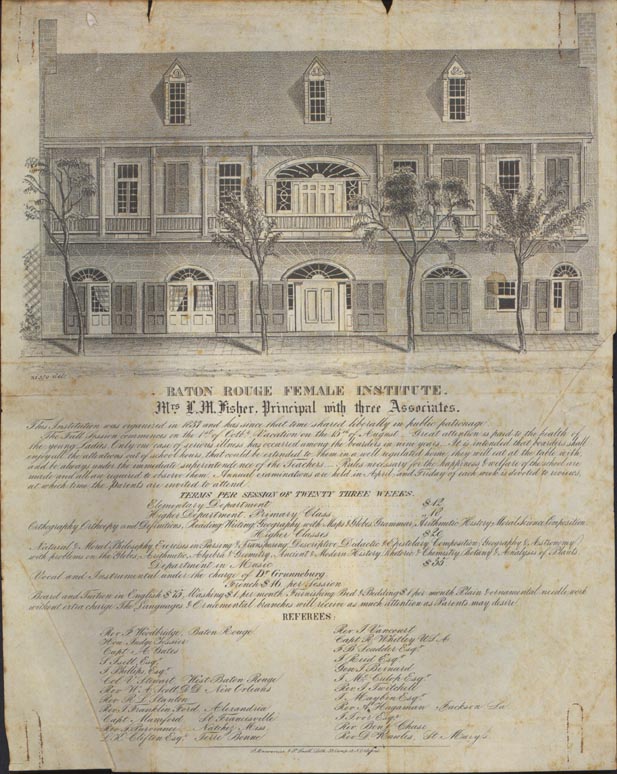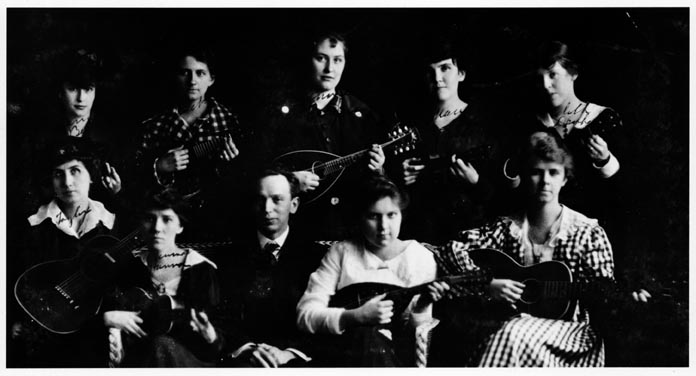
Case 6: Baton Rouge Women
Interpretive Text:
Native American women who inhabited the Baton Rouge area before Europeans invaded were food gatherers for their tribes. We know little else about their lives. Nor do we know if women, either white or African-Americans, were part of the Dartaguette settlement established in 1718. A document entitled "General Status of the Whites, Freed- Persons, and Slaves in the District of Baton Rouge for the Year 1782," in the Papeles Procedentes de Cuba , lists 30 white females, 44 black female slaves, and one free female of color as residents of Baton Rouge. The first marriage recorded in Baton Rouge occurred January 15, 1793, when Genevieve Dulat wed a Spaniard. Early Baton Rouge businesswomen included Madame Legendre, who in 1825 owned the town's largest inn. Many white Baton Rouge women owned slaves before the Civil War.
In early Baton Rouge, education for women was only for the few. Convent schools and private female institutes for the well-to-do were established in the antebellum period, but formal education was not readily available to young women of modest means. From 1890 to 1910, the sisters of St. Joseph ran an orphanage, an academy, and a commercial laundry to support them. When three public schools were established in Baton Rouge in 1848, one was for girls. None of these schools admitted African-Americans, who until the 1960s all faced the barrier of segregation in obtaining an education.
LSU, founded in 1859 and located in Baton Rouge since 1869, did not admit women until 1906, when seventeen female graduates of Baton Rouge High School were enrolled. When the campus moved to its present location in 1926, the women's classes continued to be held separately, at the old campus downtown. Nevertheless, women managed to become a part of campus life. The first musical organization for women students at LSU was the "Comus Edic," established in 1915.
The first woman radio personality in Baton Rouge was Orene Muse Huckabay in the 1940s who later worked in local television. She and her husband started the social newspaper The Register , which continues to chronicle social events in the city today under the name InRegister . The paper also features articles about prominent women, such as internationally known nutritionist Dr. Ruth Patrick. The trademark of the publication's editors, large hats, was begun by Mrs. Huckabay's "Mad Hatter's Brunch," which raised funds for charity.
Women writers have made their mark as well. Poet and educator Dr. Pinkie Gordon Lane was the first Louisiana Poet Laureate; novelist Joyce Elaine Hooper Corrington, author of A Project Named Desire, called Baton Rouge home for a number of years.
Items Displayed:
Items listed below were part of the exhibition but some are not pictured on this page.


William Octave Hart. Rights of Women in Louisiana. New Orleans: Andree & Elliott, 1910. LLMVC Rare PS664 L8 L68.
Dorothy H. Brown and Barbara C. Ewell, eds. Louisiana Women Writers: New Essays and a Comprehensive Bibliography. Baton Rouge: LSU Press, 1992. LLMVC PS266 L8 L68 1992.
InRegister:Baton Rouge's city/social publication. Baton Rouge, LA: Horn Media Consultants. Vol. 10, No. 1, July 1998. Photograph ca. 1996 by Mike LeBlanc
